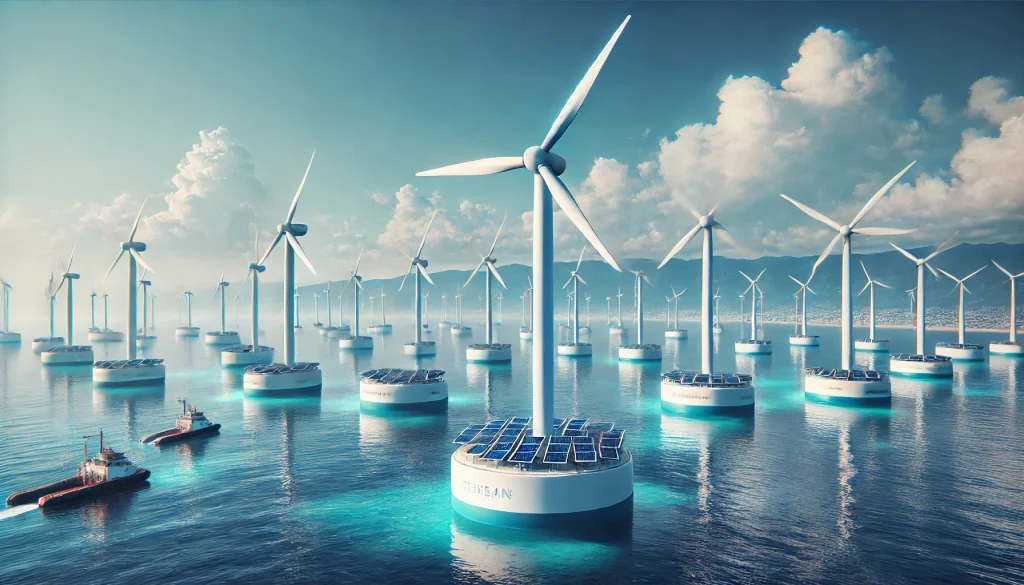Japan is making significant strides in expanding its offshore wind energy capacity, aiming to achieve 10 gigawatts (GW) by 2030 and between 30 to 45 GW by 2040. These ambitious targets are integral to the nation’s commitment to carbon neutrality by 2050. To facilitate this growth, the Japanese government has implemented several key policy reforms and strategic initiatives.
Expansion into Exclusive Economic Zones (EEZ)
In March 2024, Japan amended the “Act on Promoting the Utilization of Sea Areas” to allow offshore wind development within its Exclusive Economic Zones (EEZ). This legislative change enables the installation of wind farms beyond territorial waters, significantly increasing the available area for offshore wind projects.
The Japan Wind Power Association (JWPA) estimates that the spatial potential for offshore wind power in the EEZ is approximately 3.5 times that of onshore wind, highlighting the vast opportunities this expansion presents.
Strategic Partnerships and International Collaborations
Japan is actively collaborating with both domestic and international companies, leveraging global expertise in the development of offshore wind power. In the third round of offshore wind auctions held in December 2024, two major consortia were selected:
Aomori Tsugaru Offshore Wind Power Project (615 MW)
- Developers: JERA, Green Power Investment, Tohoku Electric Power
- Turbines: Manufactured by Siemens Gamesa
- Planned Commercial Operation: June 2030
Yamagata Yuza Offshore Wind Power Project (450 MW)
- Developers: Marubeni, Kansai Electric Power, BP IOTA (a BP subsidiary), Tokyo Gas
- Turbines: Manufactured by Siemens Gamesa
- Planned Commercial Operation: June 2030
These projects will not only accelerate the growth of Japan’s offshore wind market, but also strengthen collaboration with international companies and drive technological innovation.
Investments in Floating Offshore Wind Technology
Recognizing the importance of floating offshore wind technology, especially in deeper waters, Japan is investing in international projects to gain valuable experience. In August 2024, Tokyo Gas acquired a 21% stake in the WindFloat Atlantic floating offshore wind power project in Portugal. This investment marks Tokyo Gas’s first direct entry into an overseas floating offshore wind farm and is expected to provide insights beneficial for advancing Japan’s own floating offshore wind initiatives.
The Japanese government is also supporting the development of common foundational technologies for floating offshore wind power through NEDO (New Energy and Industrial Technology Development Organization). Efforts are underway to advance designs suitable for deep waters and to establish technologies for mass production.
Challenges and Global Context
Japan’s offshore wind power market is experiencing rapid growth, but it also faces several challenges:
- Rising costs: Global inflation and supply chain disruptions have led to increased costs for wind turbines and related equipment.
- Delays in permitting: Complex regulatory procedures have caused delays in project development.
- Grid constraints: Infrastructure improvements are needed to efficiently transmit power from large-scale wind farms.
To address these challenges, Japan is strengthening international cooperation and reviewing its policies. In particular, it is pursuing technical partnerships with leading offshore wind countries such as the United Kingdom, Norway, the Netherlands, Denmark, and the United States to enable more efficient deployment.
Conclusion
Japan’s offshore wind power sector is poised for significant growth, driven by strong government support, technological innovation, and international collaboration. Efforts are underway on multiple fronts, including the expansion of the Exclusive Economic Zone (EEZ), investment in floating wind technology, and partnerships with overseas companies.
To achieve its 2030 and 2040 targets, Japan must ensure policy stability, reduce costs, and enhance transmission infrastructure. By addressing these challenges, Japan has the potential to become a leader in offshore wind power within the Asian market.
📚 Want to dive deeper? Explore J-WIND Times’ featured categories!
🔍 Market Trends & Analysis – Stay ahead with insights into the latest developments shaping renewable energy investments.
🏛 Policy & Regulation – From auction schemes to FIP reform, get a clear understanding of Japan’s evolving energy rules.
⚙️ Projects – Discover the progress and behind-the-scenes of offshore wind projects across Japan.
💡 Technology & Innovation – From next-gen turbines to floating foundations, explore the cutting edge of offshore wind tech.



